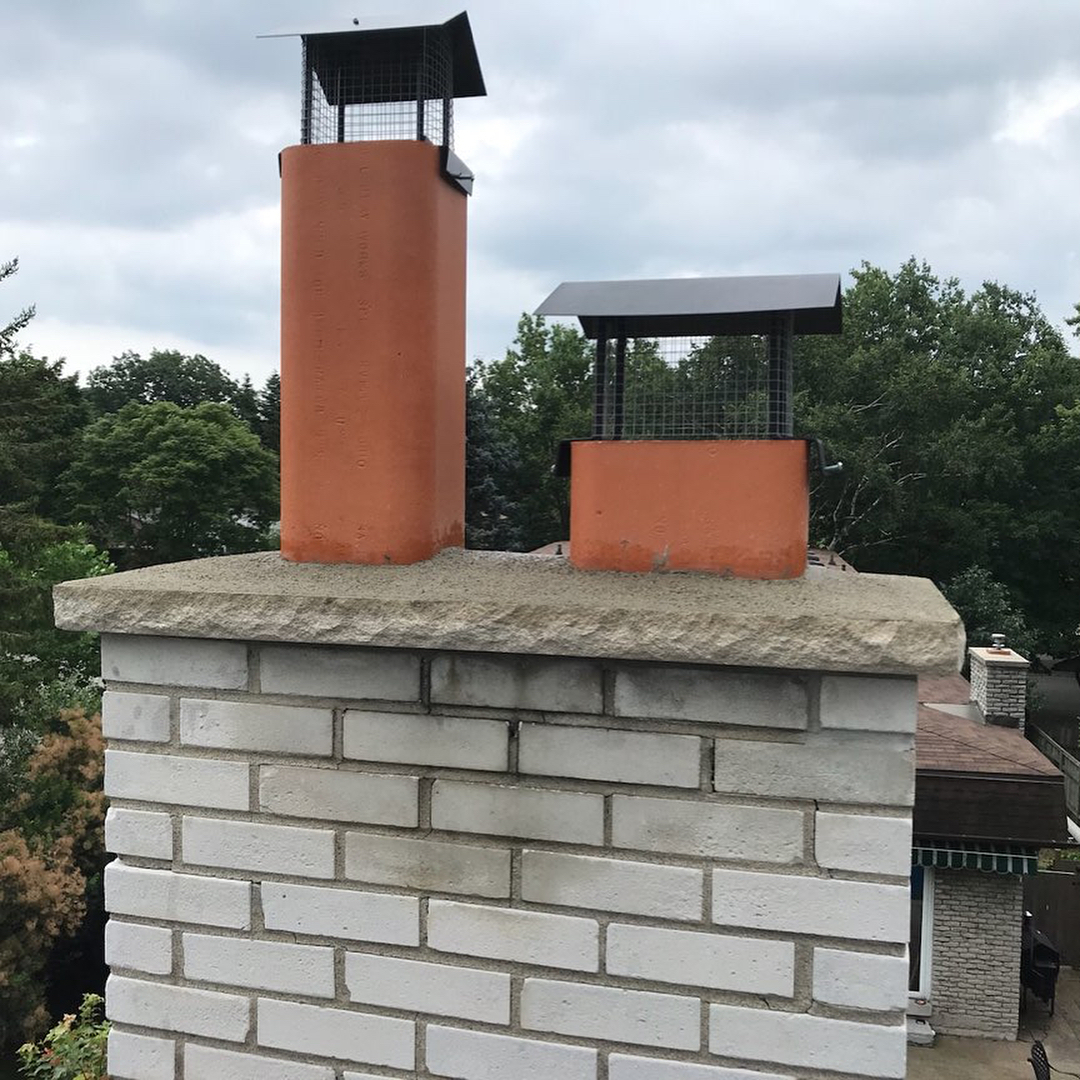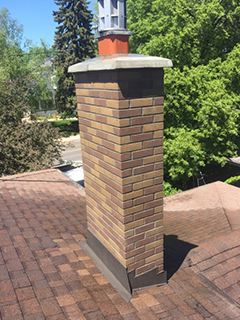Top 5 Common Masonry Repairs in the Spring
This year has turned out to be not so typical both from a weather perspective, and the fact that the vast majority of people have been isolating at home to protect against the Corona Virus.
As a result, many people have turned their attention to dealing with the various home repairs they either have noticed needing attention, or have not had the time to previously address; including masonry repairs.
The most common masonry repairs for a household can break down as follows:
Chimney Repairs:
Essentially chimney repairs involve insuring that the structural brick work of the chimney is in good order. Common maintenance can involve tuck-pointing void or cracking mortar joints between brick courses. Also tuck-pointing work involves replacing individual bricks which may be damaged. Such damage can be recognized by the facing of the bricks shaling off, or the bricks remaining saturated with moisture after a rainfall, which signals that the glazing has worn off the brick and it has become porous.
Left unattended, such brick work continues to deteriorate further courses. In cold weather; saturated bricks can freeze causing the facing of the bricks to fall off. As a result, tuck-pointing is a pro-active step to mitigate a more costly chimney rebuild.
Rebuilding a Chimney:
Is a necessary project when the chimney structure exhibits leaning, or visible deterioration of the bricks and/ or mortar joints on mass. If the chimney appears in generally rough condition; it is wiser to simply raise the chimney to below the roof line, to rebuild it. The advantage is that the job can last for decades without issue. Rebuilding the chimney will require that the metal flashings; which are designed to water-proof the junction of the chmney to roof transition points, must form part of the scope of work. At the top of the chimney; a new poured concrete or pre-cast concrete cap must be installed. If there are gas liners within the flue chambers of the chimney; they need to be re-set or replaced by a licensed gas fitter. Chimneys which service wood burning or fuel buring fireplaces will have the requirement of a metal liner.
Exterior Masonry Walls /Columns:
The GTA contains communities built over a century ago, and includes housing stock built in recent decades; constructed with primarily clay bricks. Exterior house walls should be checked annually to determine if there are areas which require tuck-pointing for maintenance; similar to chimneys.
Another common repair item involves brick piers /columns which are commonly used to support porch structures, by lending support to wood columns,that rest on the brick piers and extend upward to the porch beam.
Commonly such brick piers can settle over time, resulting in a structural leaning appearance. Under such a condition, the footings of the columns may need to be repaired or re-poured with concrete. The brick piers themselves can also be subject to deterioration, and may need tuck-pointing or rebuilding, similar to a chimney.
Foundation Walls:
In modern construction times of the past thirty years; poured concrete basement foundations tend to be the norm. Still used today, but more common in the 1960’s era and earlier; concrete block foundations were the most common method of foundation construction for residential homes. Both of these methods combined with poured concrete basement floors.
As homes age, and foundations may settle, the likelihood of foundation cracks developing can occur.
Exterior water-proofing of foundations can also become vulnerable to water ingress, often in the twenty year range, as materials deteriorate. The foundation of the home is a critical component of the building structure to keep in good repair.
Annually; one should circle check the foundation around one’s property to inspect for developed cracks or voids between the base of the foundation walls where they meet the adjacent ground surface, and to check grading; that is sheds water away from the foundation. Associated downpipes and in-ground drains should be checked to insure that there is no blockage or seeping into the basement at these vulnerable areas. Therefore; inspecting the interior walls of the basement, and paying attention to where in-ground drain locations may relate to the interior space, should form part of one’s inspection.
Other tell-tale signs of potential water intrusion, when looking inside the basement include, efflorescence marks on interior basement walls, dampness of interior basement walls or wall to floor junctions, mold, masonry basement walls bulging inward, or an extremely musty smell.
Early detection of foundation cracks can allow the homeowner to complete less costly repairs, like filling such cracks with hydraulic cement, or injecting epoxy resins to fill minor cracks. If a foundation wall is found to be more compromised; it may require being dug out to the foundation footing and waterproofed.
Cement Parging:
Many foundation walls which have a reveal above the ground grade, have a cement parging detail which provides a finished surface appearance to the area, which helps to protect underlying block beneath the surface. Over time, and with exposure to moisture and salt, parging can break down resulting in flakes or chunks dislodging from the expose wall surface.
By preparing the foundation wall surface properly, and removing all loose and shaled materials; areas can be correctly repaired. In some instances a mesh / lathe material is applied to the damaged wall surface to provide for proper adhesion of the cement parging mixture. If a particular foundation wall is primarily in good shape; repair areas can be seamlessly blended. In more severe circumstances, an entire wall section should be redone to provide for a proper finished appearance.
Walkways:
For many homeowners, the appearance of their properties entrance, as one walks toward one’s home, is an important visual item that can enhance or detract from a home’s curb appeal. If for instance, a poured concrete walkway is cracked or has heaved due to frost and or settlement, it can actually become a tripping hazard. Similarly interlock brick pathways, popularized beginning in the 1970’s; can demonstrate cracked or sinking stones, permit weed growth, and serve to date the appearance of a particular home.
The required solution becomes the repair or replacement of such areas.
In the case of paver stones; the original material can often be power washed and re- installed over a rejuvenated bed of aggregate materials beneath. This assumes the concrete pavers are in good condition. A more costly but visually appealing option is to install materials which have a classic or modern design aesthetic. Examples of such materials include modern stone or concrete paver bricks, natural stone, or combinations of complimentary materials.
Where function and cost are the top criteria; forming and pouring a new or replacement concrete walkway can be the most cost effective option.
Manufacturers of paver products and natural stone products typically have websites that depict examples of finished projects; that can demonstrate the finished result. Such websites allow the home owner to visualize the result and provides design ideas.
The replacement of poured concrete walkways, stairs, and/ or porch slabs; require that existing materials be removed, proper installation and depths of aggregate are restored, and forms are constructed, prior to actually completing the concrete pour and finishing details.
When using concrete, colour pigments can be added to result in a variety of looks and textures.
Concrete can be installed using stamps to mimic the look tiles, pavers, and other unique creative styles.
Coloured, stamped concrete, which is popular for both driveways and walkways, can provide a highly durable and visually appealing aesthetic.
Outdoor Living Environments:
As more people are spending time at home in these times; utilizing backyard spaces for recreation is becoming increasingly a requested subject.
Such items as masonry barbeques, outdoor kitchen islands, outdoor fireplaces, and stone patios, are popular retrofit projects which undeniably add enjoyment, and also value to residential properties.
Many people are electing to add features to their back yards to build onto existing elements they already have, such as decks and pool spaces.
Building an outdoor combination pizza oven and fireplace, is an affordable way to jazz up an outdoor entertaining space. Another popular choice for outdoor relaxation is the addition of a mini pond with stone elements and borders. Both of these ideas can be budget friendly, but add a considerable level of interest and appeal.
To learn more about chimneys, and fireplaces, both indoor and outdoor; visit: www.avenueroadmasonry.com or see us on Facebook™.




